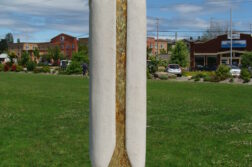Views on Shelley’s Women Clarified
To the Editor:
In his review of my book, The Shelley-Byron Men: Lost Angels of a Ruined Paradise [Jan.-Feb. 2018 issue], Daniel A. Burr notes my “animus toward the literary executors and biographers of the Romantic poets Shelley and Byron.” True, but my disapproval goes far beyond their not acknowledging “homoeroticism in the works and lives of canonized authors.” In my conclusion I write: “This story has had its ugly aspects: the destruction of documents—the falsification of lives—the defamation of good people—the misinterpretation of great poems.” Some progress has been made, but academics specializing in Romanticism are still far from gay-friendly.
Mary Shelley and her daughter-in-law Jane were not the only culprits, but they created the Shelley Legend, transforming Percy Bysshe Shelley from a radical, pagan advocate of free love, as his friends knew him, into an angelic milksop. In my book and elsewhere I have criticized some women, and some strands of feminism, but don’t think I am a “misogynist” for doing so. I have also defended women who were victims of Mary and Jane Shelley: Mary’s step-sister, Claire Clairmont; her step-mother, Mary Jane Godwin; and Shelley’s first wife, Harriet. My personal website has a book-length section, “Harriet Shelley: Wife of the Poet” (at paganpressbooks.com).
Sometimes I indulge in speculation, but I try to distinguish this from evidence-based conclusions. As to whether “members of this circle had sexual relations with one another,” I contended that Shelley and his inseparable companion, Edward Ellerker Williams, were lovers, and that they probably had sex together. As to relations among the other members of the circle, who knows? They may have had sex with each other or with Italian youths, who were presumably available to rich, good-looking Englishmen.
Although my book is akin to an overview, it is original, especially the sections on Shelley, Peacock, Williams, and Trelawny. I hope that younger gay scholars will now follow the path that I have tried to blaze.
John Lauritsen, Boston
Auden and Kallman on Fire Island
To the Editor:
Let me add a little something to Martin Duberman’s piece, “Why Auden and Kallman Endured” in the Jan.-Feb. 2018 issue. Before Auden discovered and removed himself to the Italian island of Ischia for his summer retreats, he and Chester Kallman had discovered and ensconced themselves on New York’s Fire Island in the mixed gay/straight beach colony of Cherry Grove. There, Auden co-owned with a married couple, James and Tonia (Constanze Kurella) Stern, a house named “Bective Poplars.” (It still exists today but is renamed.) They had purchased the rough cabin in 1945. “Jimmy” and Tonia were among Auden’s closest friends and completely knowledgeable and accepting of his homosexuality.
The Berg Collection at the New York Public Library contains a series of letters exchanged between Auden and the Sternses, addressed from Bective Poplars. The Sternses had taken up residence in Dorsett, England, in the summer of 1947. Auden’s letters describe the typical spring opening of any Fire Island cottage in that era. Porch screens needed repair, a cap for the Aladdin (kerosene) lamp had been misplaced. Mice had nested in a dresser drawer.
Auden had his meals provided by Duffy’s Hotel kitchen because it bored him to cook for himself more than once a day. He comments on being too fat to walk around on the beach without a bathrobe. He recounts the story of two boys arrested for swimming nude at the Cherry Grove beach in 1946 during the Sterns’ and Auden’s joint residency. Auden thought the boys had been deliberately provocative and indiscrete. He also comments about the number of “dykes” renting cottages in 1947. There exists an oft-published picture of a ten-year reunion of Stephen Spender, Auden, and Christopher Isherwood in Cherry Grove that summer. The three (along with James Stern) became buddies in Berlin in the 1930s.
Auden’s poem, “Pleasure Island” (1948) is a commentary on summers spent in Cherry Grove: “a huddle of huts related/ By planks, a dock, a state/ Of undress.” Auden had reluctantly come to terms with Kallman’s wanderlust by the time of their shared summers in Cherry Grove. The bar at Duffy’s Hotel is described by Auden as “cruisy”—for Kallman. Auden’s letters to Tonia Stern reveal an unhappy acceptance of his merely domestic relationship with Kallman. So sexually unsatisfying was it that Auden took a female lover, Rhoda Jaffe, for a brief few months. Jaffee had been a guest at the cottage in 1946.
The house at Forio d’Ischia was leased for a year starting in 1948, which is when Auden stopped frequenting Cherry Grove for the most part. The Grove was becoming too publicly gay for Auden’s sensibilities. It also became financially expedient to rent in Italy (as compared to New York City) even though Forio was also known as a “pay to play” vacationland by gay men. Auden held onto the Forio residence for ten years—Kallman remained his companion—but he also visited Cherry Grove occasionally in the 1950s. Auden and the Sternses lost the Cherry Grove cottage through a series of allegedly mismanaged property tax payments in 1961. Auden’s Berg Collection letters reveal a brilliant writer’s consternation with the dimensions of his gay life in middle age as well as a snapshot of Cherry Grove as an emergent international gay resort.
Carl Luss, New York
Cherry Grove Archives Committee
Corrections
In the Nov.-Dec. 2017 issue, in Jeffrey Meyers’ article about Klaus and Thomas Mann (p. 20), an error was introduced that changed the meaning of the following sentence (as corrected): “[Klaus Mann] also published his autobiography, The Turning Point (1942), and celebrated his homosexual heroes with biographies of ‘Mad’ King Ludwig of Bavaria, Peter Tchaikovsky, and André Gide.”
In the Jan.-Feb. 2018 issue, in Martha Stone’s roundup of 2017 deaths, the first name of the surviving partner of Ruth Mountaingrove was stated incorrectly. Her name is Jean Mountaingrove.



